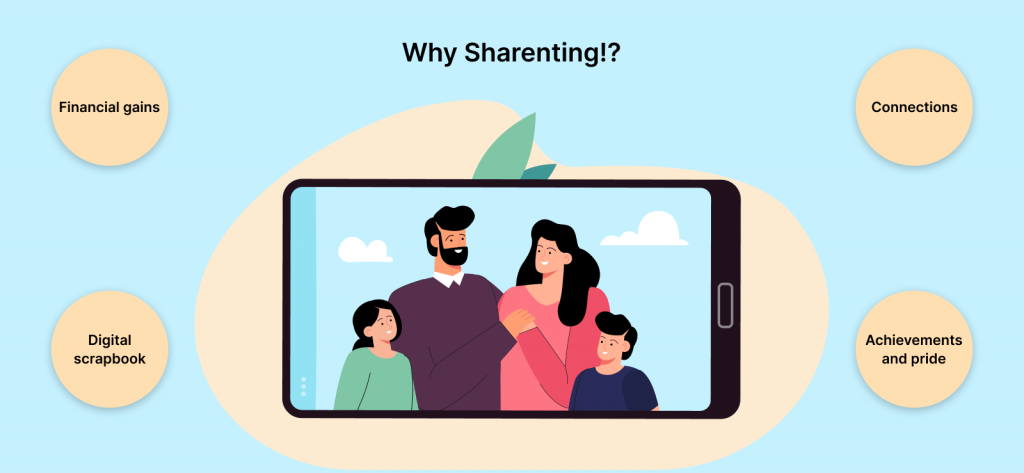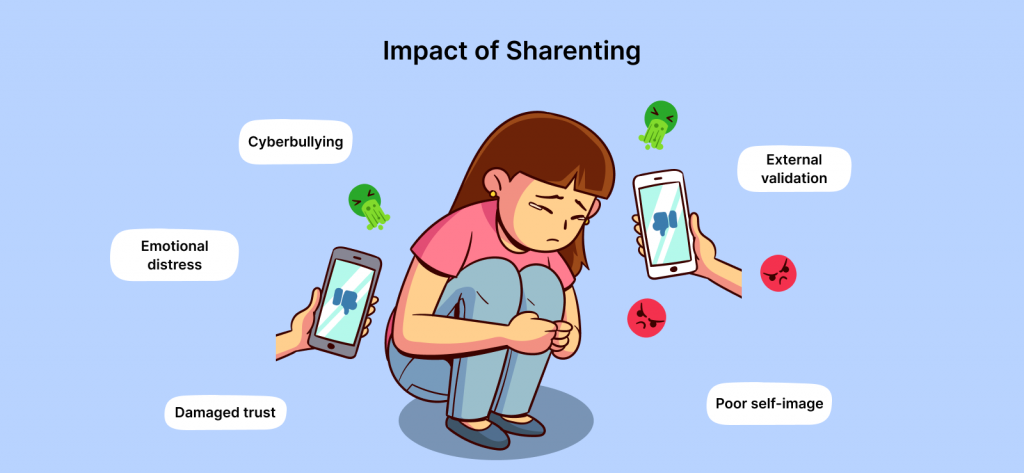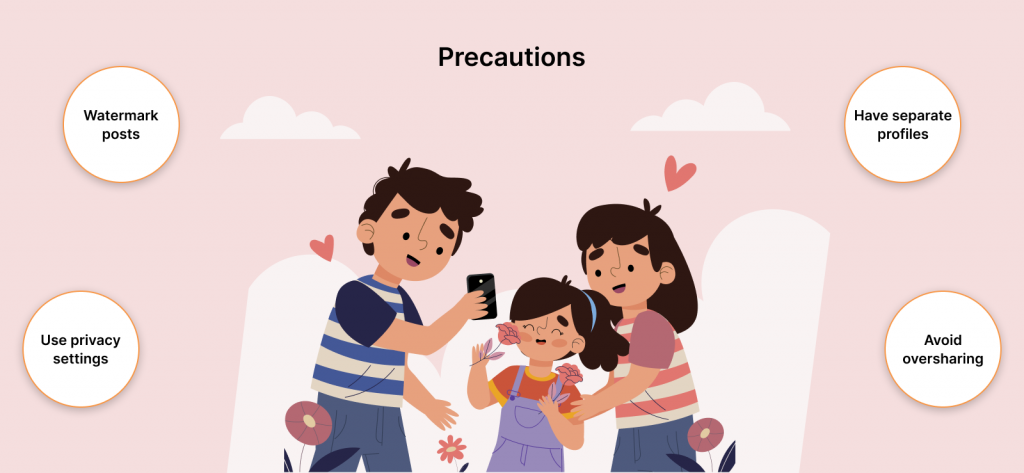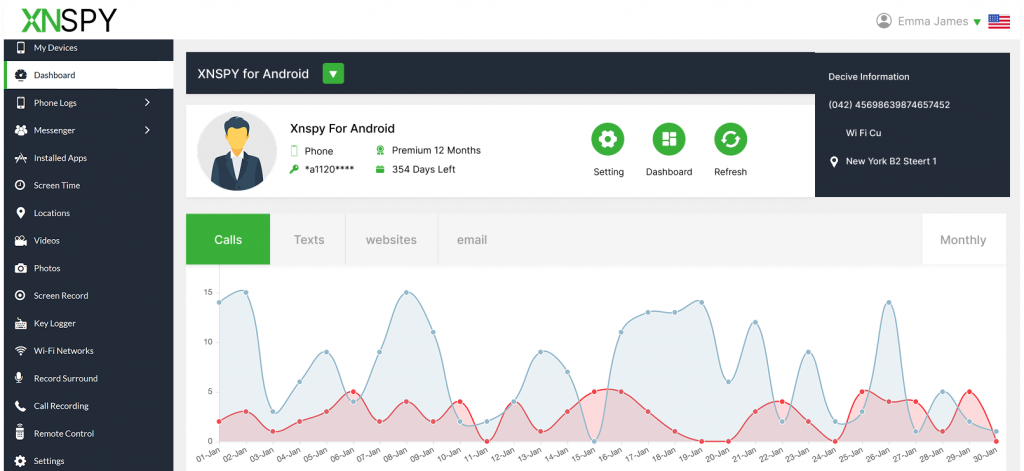The complete monitoring experience for your phone
Get XNSPY and start tracking calls, texts, multimedia, locations and more on any phone!
Get Started Now Live DemoWith social media becoming a melting pot of trends and influencers, the scope of what can be considered “content” has become limitless. Due to this, ideas such as “sharenting” have become the new normal.
But what exactly is sharenting? What does it do? And how can we move forward without being too overpowered by it? That is what this blog will attempt to answer. So keep reading to understand this new practice and its effects.
What is Sharenting? Understanding Where it Comes From
The term “sharenting” is a modern blend of the words “sharing” and “parenting.” Putting it simply, it refers to the act of parents posting photos, videos, and any other personal information about their kids on social media or other Internet platforms. It often starts from announcements of pregnancy and continues through major everyday moments.
Sharenting began as a way for parents to connect with friends and family or document memories. But with the growth of social media and influencer culture, it has evolved into its own separate genre.
Top Parenting Blogs Worth Your Time
🎮 Video Game Addiction Statistics: Latest Numbers and Trends
⚠️ 17+ Dangerous Social Media Challenges
👫 How to See if Someone Is on Dating Apps Without Them Knowing
🛑 Gen Alpha Slang: 99+ Most Popular Terms & What They Mean
Why Parents Engage in Sharenting

Parents share their children’s lives online for a variety of personal and social reasons. Some simply enjoy documenting moments, while others seek the benefits of the digital age. The motivations behind this trend are varied, but we have discussed the 3 big ones below:
1. Sharenting for Financial Gain
Financial gain is one reason some parents take part in sharenting. Popular family accounts on social media can attract many followers. Such ventures eventually lead to paid work with brands, free products, and, in larger-scale situations, sponsorships.
Parents see sharing their children’s lives as a way to earn money from everyday moments. The more they post, the more chances they have to grow their audience and increase income. Some even make full-time jobs from this kind of content. While it can be rewarding, making money this way also leads to questions of privacy and being in the public eye.
2. Sharenting for Pride and Connection
Pride and connection are also common reasons why parents share their children’s lives online. Posting milestones and everyday moments can feel like celebrating their child with friends and family. Social media helps loved ones near and far stay updated and feel part of a child’s life.
Many parents enjoy the kind words and encouragement they get from others, which can make them feel supported. Sharing online can also help parents feel closer to their child as they reflect on special moments. For some, sharenting becomes a way to create a warm, shared story of family life with their wider circle.
3. Sharenting to Create a Digital “Scrapbook”
An emerging pattern among a lot of parents when it comes to sharenting is the creation of digital scrapbooks and journals. Basically, social media becomes an easy outlet to store and organize memories, from their kids’ first steps to school events and family outings. The intention is to look back at these posts to relive special moments and track their child’s growth over time.
Unlike traditional photo albums, online platforms keep these memories accessible anywhere and can also make them easy to share. For parents with hectic schedules, this method becomes long-lasting and easy. However, while this approach preserves precious memories, it also adds to a child’s online footprint, which may remain visible long after the moment has passed.
The Dark Side: Sharenting Dangers You Should Consider

While a majority of sharenting might come from a place of love and pride, it can also expose children to serious risks. Understanding these potential harms can help you make safer choices about when and how much to share about your child online.
1. Sharenting Can Expose Sensitive Personal Details Online
Privacy is one of the biggest risks of sharenting. The simple act of sharing photos and videos can give away more than parents think, like a child’s name, birthday, school, or places they frequently visit. Even small background details can help strangers figure out where a child lives or spends time.
Once something is posted online, it can be copied or saved without permission, and then removing it from everywhere is a very difficult thing to do. Over time, these posts create a permanent record of the child’s life before they are old enough to agree. This can affect their safety and privacy in a way that is tough to predict.
2. Posts May Open Doors to Cybersecurity Threats and Identity Theft
Cybersecurity threats are another growing problem related to sharenting. When parents share details online, they might give cybercriminals clues that can be used for hacking or identity theft. Even innocent-looking photos can contain hidden data, such as location information from geotags.
Aside from this, some people can also download and reuse children’s images to create fake profiles or spread them on unsafe websites. Because children rarely have credit or accounts in their name, stolen identities can be misused for years before anyone notices. Sharing too much online can become a rabbit hole of digital threats that are difficult to stop or undo.
3. Children Can Feel Pressured to Perform for Social Media Attention
Another harmful outcome of sharenting is that it can make children very aware of being on camera, which may lead them to change how they act. Instead of behaving naturally, they might start doing things just to get attention or please an audience online.
Over time, special moments can feel staged rather than real. Some children may even judge their worth by the number of likes or comments a post gets. This can affect how they see themselves and how confident they feel. Growing up this way can make it hard for them to tell the difference between real life and acting for social media content.
4. Shared Content Creates a Permanent Digital Footprint for Kids
One of the biggest dangers of sharenting is that anything shared online can last forever. Even if a post is deleted, it may have already been copied or shared. Once images or personal details are on the internet, parents lose control over where they go or how they’re used.
This permanent digital footprint can follow a child into adulthood and affect their privacy, reputation, and even their future opportunities. What feels like a harmless post today could resurface years later in a very different and problematic way. The long-lasting nature of digital content makes careful sharing essential for a child’s protection.

Keep Your Kid’s Digital World Safe
Xnspy gives you a clear view of your child’s digital world so you can step in at the right time.
- Track calls, messages, and social media activity
- Monitor location and set safe zones with geofencing
- Review browsing history and app usage anytime
The Impact of Sharenting on Children

Sharenting can affect children in many ways, both while they are young and as they grow older. The things parents share online can shape how children feel about themselves. Keep reading to see the most harmful effects.
1. Oversharing Can Lead to Emotional Distress in Children
Sharenting can cause emotional distress for children, especially if their embarrassing or personal moments are shared online without their consent. A funny photo or story to a parent might feel humiliating to a child, leading to feelings of shame or embarrassment.
What makes this even more serious is that half of all mental health disorders first appear by age 14. That means the pressure or anxiety caused by sharenting is happening right at the age when children are most vulnerable to developing lasting mental health challenges.
As they grow older, children may become upset that private parts of their lives are permanently on display for the whole world to see.
Negative comments or teasing from peers can make these feelings worse and can be a major blow to their self-esteem and trust. In some cases, constant exposure online can create anxiety about how they are seen, making them feel pressure to act a certain way.
2. Online Posts May Trigger Cyberbullying and Public Humiliation
When parents share content about their children online, they can also unintentionally open the door to cyberbullying and public humiliation. Media that is shared can be picked up by peers or strangers and used to tease or mock children. Even posts meant to be funny or lighthearted can be taken out of context and spread quickly.
This is especially concerning given that 46% of U.S. teens aged 13 to 17 have experienced cyberbullying in their lives. For a child, having personal content circulated online only increases the chances of becoming part of that statistic.
Once shared beyond the parents’ control, this content can follow a child for years. Such experiences can damage their sense of self and also create feelings of embarrassment or isolation. The end result? Lasting emotional scars and a constant feeling of stress and detachment from the outside world.
3. Sharing Without Consent Can Damage Parent–Child Trust
Sharing a child’s personal moments online without consent can also be a one-way ticket to a lack of trust. The act can slowly weaken their connection with their parent. When kids feel their privacy is overlooked, they may become less open about their thoughts or experiences. Over time, repeated oversharing can create feelings of betrayal, especially if posts lead to teasing or embarrassment.
Trust is essential for a strong parent–child relationship, and once it starts to fade, communication and closeness can suffer. Rebuilding that trust can be challenging, particularly as the child grows older and becomes more aware of how their life has been shared with the public.
4. Constant Exposure Online Can Undermine a Child’s Confidence
When you grow up with a large part of your life being shared online, it can inevitably influence how you see yourself. Similarly, constant exposure to comments and comparisons can cause them to seek validation from others instead of feeling secure in who they are.
Even well-meaning posts can set unrealistic standards, making children feel that they always have to look a certain way or show certain emotions to be loved and accepted.
Negative feedback or teasing can also be a detriment to their self-image. Over time, this dependence on external approval can weaken inner confidence, making it harder for children to develop a strong and authentic sense of self as they grow.
Real-Life Sharenting Examples That Reveal Serious Downsides
We have talked about the sharing risks and impact in theory, but nothing hits harder than seeing what actually happened to real families. These sharenting examples are real stories that show how quickly things can spiral once a child’s life is shared online.
Case 1: The Ace Family
The ACE Family, a popular YouTube family channel run by Austin McBroom and Catherine Paiz, is a major example of sharenting. Their content frequently features their kids in daily vlogs, pranks, and brand promotions. So they are accused of turning their family life into a profitable business.
Critics often point out instances where children were filmed during emotional moments, and even dragged into Austin McBroom’s cheating scandal. This has led to more and more debates about consent and emotional well-being.
Moreover, viewers have pointed out that in many moments, the frightened reactions of the children appeared a bit too realistic for them to be just plain pranks. This led to more backlash for the parents.
Case 2: The Popularity of Charli D’Amelio
Charli D’Amelio quickly became a viral TikTok sensation at the young age of 15. However, under the cover of a bright, bubbly girl who does this as a hobby, were her parents. The more fame that Charli received for her content, the more her other family members utilized to build an empire.
This led Charli to severe emotional distress as she battled with severe depression and anxiety. After leaving her family home, she became more candid about her experiences following this closeted sharenting. This gives us profound insight into how it can also be a concealed practice.
What Precautions Should Parents Take When Sharenting?

Understanding the sharenting meaning is only the first step toward protecting children online. Parents need to be aware of the risks and take clear precautions before posting. Simple changes in how and what is shared can make a big difference in protecting a child’s privacy and long-term well-being.
1. Think Before You Post
One of the simplest but most effective precautions against the risks of sharenting is to pause and think before posting. Parents should consider how a child might feel about the content now and in the future, and whether it reveals personal details like location or school.
Asking questions such as, “Would my kid be comfortable with this?” or “Could this post lead to something bad?” can help guide safer choices. Taking a moment to reflect reduces the chance of oversharing and ensures that what’s shared online is respectful and in the child’s best interests.
2. Separate Your Public and Private Profiles
Keeping public and private profiles separate is another useful way to lower the risks of sharenting. A private account can be shared only with close friends and family, making it harder for strangers to see a child’s photo or details.
Public accounts, especially for work or business, should avoid posting any personal information about children. Having this clear divide helps parents protect their child’s privacy while still being active online. It also gives more control over who can view family moments and lowers the chances of the content being copied.
3. Watermark Your Posts
Using watermarks on photos and videos can help make sharenting safer. A watermark is a small name or mark placed over the image to show ownership. When positioned where it’s hard to remove, it discourages people from copying or using the content without consent.
Parent who share their children’s pictures online can use this simple tool to make images less appealing for misuse. While a watermark can’t stop all unauthorized use, it does add a visible layer of protection and serves as a clear reminder that the content is personal and not meant for public exploitation or distribution.
4. Avoid Identifiable Information
Another key step in safer sharenting is making posts that don’t include details that could point to your child’s identity or location. Skip showing things like school logos, uniforms, street names, house numbers, or recognizable landmarks in the background. Even small hints can help strangers piece together where your child lives.
Aside from this, captions matter too, so it is recommended to leave out birthdays or full names. By keeping these personal details private, parents can still share meaningful moments online while protecting their child from unwanted attention or other safety concerns beyond their immediate circle.
5. Use Privacy Settings
Using privacy settings is an effective way to control who can see your child’s content online. Most social media platforms allow you to limit posts to friends or approved followers. Adjust settings to prevent strangers from accessing photos or personal information.
Parents can also review tagged content and shared posts to make sure nothing is publicly visible without consent. Regularly update these settings to add an extra layer of protection, helping keep children’s online presence private. By taking advantage of privacy tools, parents can enjoy sharing moments safely while reducing risks associated with sharenting.
The Way Forward: Seeing the Other Side of the Story

Now that we are all on the same page about sharenting, we can agree that it has some severe repercussions for children. But what if the tables were flipped? What if it were the kids themselves who were putting themselves out there without the fear of any consequences? As a parent, that is also a scary thought.
So, it is important to take proper precautions. This is where the Xnspy phone monitoring app can help. With it, you can see exactly what your kids are sharing online – messages, photos, social media posts – without them even knowing. It tracks who they are talking to, what apps they are using, and even their location in real time.
With Xnspy, you get a clear picture of their digital world. If something looks off. like risky messages or oversharing, you will know immediately. You can step in to guide them or just have a conversation before it becomes a real problem. Xnspy also keeps a log of everything, so you can review patterns over time instead of reacting to one-off posts.
Xnspy works best when paired with open communication. Don’t think it can replace conversations. In fact, it enhances them by giving you insight into your children’s online activity. This understanding allows you to guide kids on online safety, privacy, and responsible digital behavior and help them make smarter choices.
Xnspy is one part of a larger digital parenting strategy. It provides valuable information while supporting trust and dialogue, helping families create a safer online environment together.
Conclusion
At the end of the day, social media is just a performative place, with limitless choice and opportunities. But it still comes with some risks. As a parent, you hold a vital responsibility to make sure that your kids are not put in unnecessary danger.
Sharenting can be a good way to document your child’s growth, but it should always be done with certain necessary initiatives. Safety is always the first step towards anything happening on the internet.



